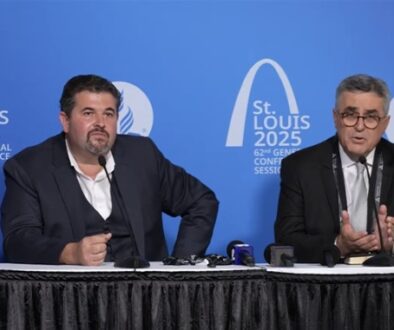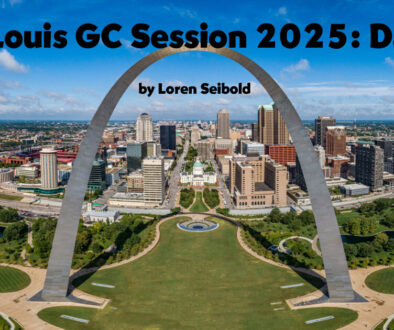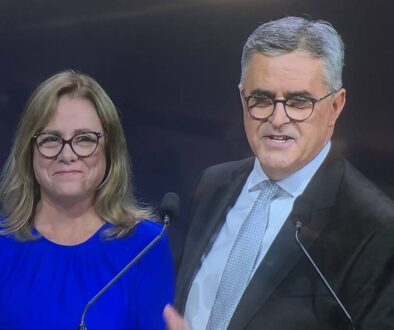Annual Council 2017, Day 3: Statistics, Policy and Rebellion
By Loren Seibold, October 8, 2017: The temptation, when you’re in a setting where you know there’s a conflict hanging over everyone’s heads, is to read that conflict into everything that happens, everything that’s said. You can start to see sinister motives in the most innocent happenings. But when the tension lies as heavy on the room as a 90 degree dew point, it’s hard not to analyze every word and gesture and intonation as having some reference to the current situation.
Feeling called to do more? Join Adventist Today!
Of course, some words and events, which may appear innocent, actually do have reference to the current situation, as you’ll see in today’s report.
Some things that happened today, not necessarily in order:
- Worship by Michael Hasel, theology teacher and archaeologist from Southern Adventist University, about how history and archaeology back up the Bible—in this case, David. Text: 1 Samuel 17. Quote: “Take David and Solomon out of the book, and it is a work of fiction. The real David of history matters, because he speaks to our identity and why we are here.”
- Elder Ted Wilson, GC president, announced that later in the week there will be a presentation by Coming Out Ministries, an organization that teaches that homosexuality can be overcome by the power of Christ. This is not the first time Wayne Blakely and his associates have appeared at the GC Executive Committee. This seems to be an ongoing concern of Elder Wilson’s.
- Former GC officers who died recently: Clyde O. Franz, Athel Tolhurst, and a past president of Andrews University, Dr. Richard Lesher.
- Dr. Landless introduced Gateway to Wholeness, a program by psychologist Dr. Kenneth Pargament to help people combat pornography addiction. One in three Christian men struggle with this, and some women. The internet provides, access, affordability and anonymity. Program should be made available by year’s end.
- Election of a new associate stewardship director of the General Conference: Eric J. Barbe, from Mauritius.
- Geoscience Research Institute (GRI): According to the presenter, “Darwin was wrong when he claimed that diverse organisms were created by natural selection.” Scientists, he says, are now skeptical about Darwinism. GRI is proposing establishing “creation centers” in schools and church headquarters, and continues to promote the annual Creation Sabbath.
- Dr. Gary Krause talked about the mission landscape. The North American Division still sends more missionaries than any other division. Report on the expansion of the Institute of World Mission. Also, check out the Mission 360 video program. (Remember the Mission Spotlight of our childhood—the boxes with a cassette tape and a slide carousel? Now it’s online—and seems to have less visibility. I think there was something in that process of mailing it from church to church that made us appreciate it more.)
- According to Gary Krause, a new Adventist congregation is planted every 2.7 hours.
- In the 2015 GC Executive Committee spring meeting money was voted to create an online Encyclopedia of Seventh-day Adventists that will contain photographs, media, history, and primary source documents, with articles translated into several languages. Dr. David Trim outlined the possibilities, and was open for suggestions. Quote: “By 2023 it will be the most plagiarized site in Adventism.”
- Elder Larry Evans leads an effort to help people who have needs, from blindness and deafness, to mental illness, to caregivers. He takes an ability-based approach, that it isn’t what you can’t do and need help with, but what you can do—not original, but nice to hear in our church. Check out Specialneeds.adventist.org, and a video interview we’ll put up as soon as we can.
Church Demographics
Trim talked about church stats and demographics. He said there’s a new conversion every 23 seconds. “Ellen White says we will enjoy a day of Pentecostal mission increase: that day has come.” (I want to believe you, David, but it doesn’t feel that way in rural Ohio.)
What drives the increase? “Planting new churches is one of the best ways to fuel growth.”
Something we’ve noticed at this year’s GCEC is that most of the growth talk is about planting churches, creating disciples, establishing centers of influence. In fact, words like baptism, evangelism and soul-winning are seldom used. I want to understand this. Is it because they realize that the old metric of how many people you managed to get under water was ruined by unethical evangelistic methodologies—where people came in but didn’t stay? Is it that in many countries of the world, the typical short “crusade” is useless? That long-term influence is (we hope) more successful? In any case, I like it. The new metrics are probably expressed better in narrative than in numbers and charts, the latter of which rarely mean strengthened churches.
Trim has long bemoaned that the church around the world is more interested in counting accessions than admitting to losses—which means that the big membership numbers we brag about (20 million is often used) are probably exaggerated. (Of course, if your Division doesn’t clean up the books, you get better representation in the world church!)
Why don’t we count members when they leave? “Whenever organizations try to measure how well they’re doing they begin to optimize for whatever is being measured, rather than doing good work.” Trim cited what’s known as Goodhart’s law: when a measure becomes a target, it ceases to be a good measure.
Still, the church is doing pretty good. The ratio of Adventists to world population is improving: in 2015 it was one Adventist to 384 people, which number is now 1 to 371, although Trim implied that will go down with needed membership audits.
Of course, most of the growth is in the global south. One third of the world’s countries are in the 10/40 window, but only 2.9 million of our 20 million members.
Urban ministries has been a big push at the GC. But the statistics in the cities are still worse than elsewhere. We Adventists haven’t traditionally been an urban people.
Quote: “Counting is only a means to an end, not an end in itself. The end we have in sight is the Second Coming and the return of our Lord and Savior Jesus Christ.”
The Secretary’s “Report”
Perhaps you have already looked at the PowerPoint slides that were included in the agenda as Dr. G. T. Ng’s secretary’s “report.” Well, it wasn’t really a report. One could charitably call it a history lesson, except that it wasn’t particularly good history, either. It was called “Adventism 911,”—that is to say, this is an emergency in the church such as when American’s dial 911 on a telephone to get the police or fire department.
Elder Ng took us through seven crises the Adventist denomination has faced, starting with the Marion defection (the memorable Snook and Brinkerhoff) which resulted in the Church of God Seventh Day, Canright’s defection and subsequent anti-Adventist books, the 1888 righteousness by faith controversy (Jones and Waggoner), the 1901 reorganization, the Kellogg crisis, Conradi’s defection, and what Elder Ng labelled “the Ford crisis.”
All of these things happened, but they struck me as a lot of dissimilar beads that only went together because they were strung on the same string. (For example, 1888 and 1901 were really about the brethren refusing to hear the Lord’s word—which applicability to the current situation wasn’t addressed by Elder Ng). After each of them, he showed a few lines of membership and tithe data from that time, showing that the church continued to thrive. “The church continued on!”
The message: rebellion doesn’t work. The denomination always wins. There wasn’t a person in the room who didn’t realize that this was a warning to the women’s ordination crowd that they’re number 8—and the church will go on quite happily without them. Indeed, one of Elder Ng’s summary points was “Remind us that rebellion has no future.”
This wasn’t a report, as Danish Union president Thomas Müller diplomatically pointed out at the end. Elder Müller asked that the purpose of this talk be clarified. Was this, he asked, a warm up for Monday afternoon? The presentation, after all was about rebellion. But, he pointed out, what we’re discussing tomorrow isn’t about leaders being rebellious, but a totally different sort of thing. Dr. Ricardo Graham followed Elder Müller to the microphone to suggest that the material presented was a burden our speaker rightfully felt, but it should be recorded in the minutes not as a report, but as a presentation.
Elder Ted Wilson replied, dismissively and with soupçon of scorn, “Our secretary in his report can say anything he wants to say.”
Gulp.
The Policy Nap
I would like to tell you that the presentation on policy, and the policy changes, were fascinating, But no. Myron Iseminger (GC undersecretary) is one of the nicest people in that building, but almost every year this section seems to drag on too long. First was an excessively long training session on what policy is and how it’s made. Iseminger added quizzes after each section—the prizes were policy books autographed by Elder Wilson!—but even that didn’t help.
Some highlights:
- The first policy meeting was in 1917, the first Manual for Ministers in 1925, Working Policy in 1926, and Church Manual, 1932
- Quote: “Policy is the result of unity, not the cause of it.”
- The first policy book was 60+ pages; the current one is 790 pages.
- There were a number of changes to policy made today, though most of them were minor matters of consistency. “A” changed to “the” sort of thing. (This kind of stuff is chloroform to me—and probably a lot of other people.)
Mostly, though, it was just too long. The only stirring of interest came when a change to the constitution and bylaws was recommended that included a provision about removing members from the GC Executive Committee. Elder Lowell Cooper (a retired GC vice president) walked to the microphone and said, “As this has more than a tangential relationship with a matter to be discussed tomorrow, I ask that it be delayed until after tomorrow.” The chairperson, Ella Simmons, agreed immediately with no discussion or objection.
Another Discourteous Moment
At the end of the meeting, Dr. Dave Weigley came to the microphone. Dr. Weigley is president of the Columbia Union Conference. What we’re talking about tomorrow is very important, he said. He asked that members be given the document they’ll be discussing tonight, so they could study it in preparation for tomorrow.
Elder Wilson’s dismissal was, it seemed to me, even less polite than the earlier one. He said, hardly looking at Weigley, “Alright, thank you for your request, our plan is that the document will be released at the time of our session tomorrow”—and then moved on as if he had just had to swat away a fly. Weigley looked defeated as he sat down, and I felt bad for him: he’s a marvelous man, and one of my heroes.
Tomorrow?
For the discussion of the proposed loyalty oath (someone today referred to it as a “conflict of interest statement”), we gather at 1:30 PM. Members and invitees admitted first, and others if there’s room. I was told they’d still have our press tables in the back. The rumor that this would be an executive session, and that the document would have to be signed on the spot, do not appear to be true. Please follow us on live Twitter.
Loren Seibold is a pastor, and the Executive Editor of Adventist Today.




